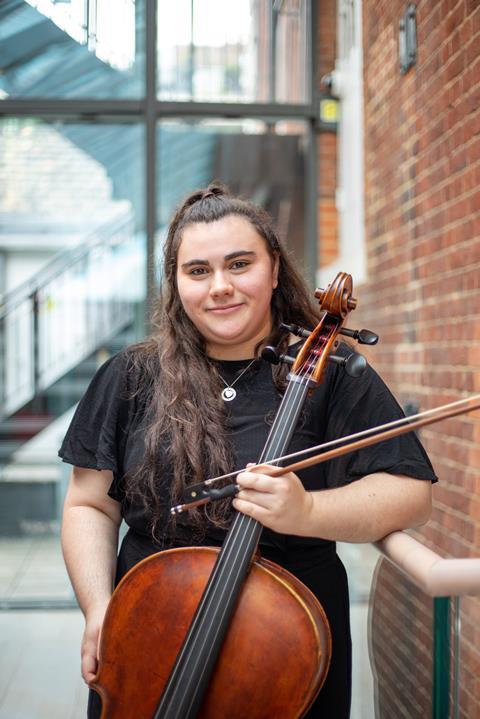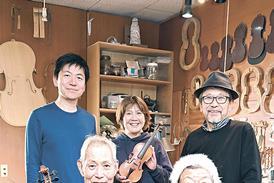Ellen Baumring-Gledhill shares her practice and preparation for performing the concerto with Junior Guildhall Symphony Orchestra at Milton Court

Read more student and player experiences in our Student Hub
In 2020, when I won Junior Guildhall’s Lutine Prize, the country was in the midst of the Covid pandemic; the first round took place virtually and the delayed Milton Court Final was socially distanced with no audience. The opportunity to play a concerto with the Junior Guildhall Symphony Orchestra (JGSO) was part of my prize and, three years on, I am delighted to be playing the Lalo Cello Concerto with JGSO in front of a real live audience. In choosing which concerto to play, I wanted to select a work that is less frequently performed but showcases the cello well with its singing qualities and fullness of tone. The Lalo Cello Concerto seemed the ideal choice.
Lalo was French but had Spanish ancestry and the Spanish influence on his Cello Concerto is evident across all three movements. A violinist and composer, Lalo also studied the cello with Pierre Baumann at the Lille Conservatoire which he attended between the ages of 10 and 16, before going on to study violin and composition at the Paris Conservatoire. Although Lalo was 53 when he wrote this work in 1876, his insight into this composition in relation to the cello was likely influenced by his own recollections and knowledge of the instrument in his early teenage years, making it a fitting work to play with the Junior Guildhall Symphony Orchestra.
I am the fifth generation of string players in my family; both my great uncle, the violinist Michael Spivakowsky, and my uncle, cellist Oliver Gledhill, studied at Guildhall School of Music & Drama. It was my uncle who inspired me to want to play the cello, he introduced me to this concerto and taught me at Junior Guildhall until I was 18. I am now in my third year at the Royal Academy of Music, studying with Felix Schmidt.
The days at the Academy are always busy. As well as preparing for my performance of the Lalo Concerto, I am also playing the Elgar Concerto in March and rehearsing for chamber music concerts. While my preparation for this performance of the Lalo Cello Concerto began some time ago, here I will share a flavour of what the last week has been like:
Over the week I have been particularly working on bringing out the Spanish influences on rhythms and character in the Lalo, such as the triplet rhythms, grace note flourishes and spiccato effects. I learned that the introduction to the third movement is based on a Spanish folk theme which, interestingly, Sarasate also later used in his Habanera. Having previously played pieces by Spanish composers including Gaspar Cassadó’s Suite for Solo Cello and Manuel de Falla’s Ritual Fire Dance, I was able to draw on some of the rhythmic shapes from these works to inform my interpretation of the concerto.
Interestingly, Lalo’s Concerto includes little thumb position and few chords and instead shows its virtuosity through single-lined passagework, varieties of bow stroke and boldness of tone together with the Spanish rhythmic features. However, I haven’t missed out on thumb position as, alongside the Lalo, I have been preparing Piatti’s Caprice No. 3 for my forthcoming study exam at the Royal Academy of Music!
Read: Masterclass: Torleif Thedéen on the Lalo Cello Concerto
Watch: Pablo Ferrández and Kian Soltani perform Paganini’s Caprice no.24
Over the week, my practice has been going well and I used the opportunities afforded by a Performance Class on Tuesday and a Strings Platform later in the week to perform all three movements with piano to an audience.
On Wednesday after my cello lesson, I headed to the Academy for chamber music rehearsals and in the evening had the opportunity to rehearse the Lalo and play it through with a local orchestra. Armed with biscuits for the players in the break, I set off for the rehearsal. Although I’d already had two rehearsals with the Junior Guildhall Symphony Orchestra, it was extremely useful to be able to play the whole work through from beginning to end to give me a real sense of what that feels like and also to help me internalise the orchestral score and how it fits with my own part.
On Saturday, after my teaching job at the Youth Music Centre, I travelled to Guildhall School to rehearse with the orchestra. On the way, I reflected on the familiarity of the route which I used to take every Saturday between the ages of 11 and 18. Sitting on the Milton Court stage for the rehearsal, I recalled my first concert with the orchestra as a Junior Guildhall student and a wave of excitement came over me as I thought ahead to my performance of the Lalo Concerto as soloist with that same orchestra this month, with 2023 rather aptly being the 200-year anniversary of Lalo’s birth.
Ellen Baumring-Gledhill will perform Lalo’s ‘Cello Concerto in D minor’ with the Junior Guildhall Symphony Orchestra on Saturday 25 March at Milton Court Concert Hall. Tickets are available here: https://www.gsmd.ac.uk/whats-on/junior-guildhall-symphony-orchestra-string-ensemble-25march.
Read: Bach Cello Suites: What do we really know about Bach’s Cello Suites?
Read: In Focus: A 1957 cello by Sesto Rocchi
Read: Elgar Cello Concerto: The classic interpretation
Read more student and player experiences in our Student Hub
The number one source for playing and teaching books, guides, CDs, calendars and back issues of the magazine.
In The Best of Technique you’ll discover the top playing tips of the world’s leading string players and teachers. It’s packed full of exercises for students, plus examples from the standard repertoire to show you how to integrate the technique into your playing.
The Strad’s Masterclass series brings together the finest string players with some of the greatest string works ever written. Always one of our most popular sections, Masterclass has been an invaluable aid to aspiring soloists, chamber musicians and string teachers since the 1990s.
This year’s calendar celebrates the top instruments played by members of the Australian Chamber Orchestra, Melbourne Symphony, Australian String Quartet and some of the country’s greatest soloists.












































No comments yet